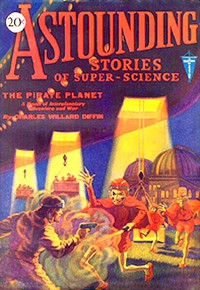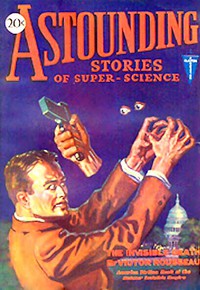Astounding Stories of Super-Science, November, 1930 by Various (spanish books to read .TXT) 📖

- Author: Various
Book online «Astounding Stories of Super-Science, November, 1930 by Various (spanish books to read .TXT) 📖». Author Various
Seismographs in all parts of the world recorded the tremors of the Earth, each indicating that the disturbance had occurred somewhere beneath the Atlantic ocean. Evidently the fourth meteor had fallen into the ocean, for the shaking of the Earth was obviously the result of the collision. That quakes had not followed the landing of the first three was due to the fact that they had been far smaller than the fourth.
And then, a short time after the earthquake, the worst storm in two hundred years broke over the Atlantic. Waves, mountain high, piled themselves upon each other in a wild frenzy; a shrieking wind lashed the waters into a liquid chaos. Great ocean-liners were tossed about like tiny chips; an appalling number of smaller ships were lost in that insane storm.
Nor was the destruction confined to the sea, for all along the Atlantic coast of North America and Europe, mighty walls of water rushed in, and wrecked entire towns and cities.
Fortunately the storm was of short[213] duration; a few hours after it began, it subsided.
For a number of weeks public attention was centered upon the meteors and storm; but gradually, when nothing further occurred, the fickle interest of the masses began to wane. A month after the storm, the strange meteors were no longer mentioned by the press, and consequently, had passed from the public mind. Only the astronomers remembered, keeping their telescopes trained on Venus night after night.
Four months passed by during which nothing of an unusual nature came to the attention of the world. But at the end of that time, it suddenly dawned upon those nations whose shores touched the Atlantic ocean, that something extraordinary was happening. It was taking place so insidiously, so quietly, that it had attracted no great attention.
A series of inexplicable sea disasters had begun. Every ship that had traveled over a certain, regular steamship route, had disappeared, leaving no trace. Mysteriously, without warning, they had vanished; without a single S O S being sent, seven freighters had been lost. The disappearances had been called to the world's attention by the shipping companies, alarmed at the gradual loss of their boats.
Then other mysterious vanishings came to the attention of the world. Ships in all parts of the Atlantic were being lost. When this fact became known, trans-Atlantic commerce ceased almost over night. With the exception of a few privately owned yachts and freighters, the Atlantic became deserted.
And finally, a few days after the world became aware of the strange disappearances on the Atlantic, the Gray Plague introduced itself to humanity. Attempts were made to repress the facts: but the tragedy of the freighter, Charleston, in all its ghastliness and horror, became known in spite of all attempts at secrecy.
On the morning of August 3rd, the Charleston was found, half buried in the sand of a beach on the coast of Florida, cast there, evidently, by a passing storm. The freighter had been one of the first boats to disappear.
When the ship's discoverers boarded her, their eyes were greeted by a sight whose ghastliness filled them with a numbing horror. Indeed, so terrifying was the spectacle on the Charleston, that the discoverers, four boys of adolescent age, left in fear-stricken haste. Nor could they be induced to return to the ship's deck.
ater, a group of men from a nearby town boarded the freighter to investigate the boys' amazing report. In the group was a newspaper reporter who chanced to be in the vicinity on a minor story. It was through the reporter's account that the facts became known as quickly as they did.
When the men clambered up the side of the Charleston to her deck, they saw a spectacle the like of which had never before been seen on Earth. Although they had been prepared for the horror to some extent by the story of the boys, the sight on the Charleston exceeded their description to such a degree that, for the moment, the men were rendered speechless.
The deck of the Charleston was a shambles—a scene of sudden, chilling death. All about were strewn gray, lifeless bodies. Death had overtaken the crew in the midst of their duties, suddenly, without warning, it seemed. Bodies strewn about—yet nowhere was there sign of decay! Bodies, lifeless for days, or weeks—yet intact!
The men were fearfully impressed by the strangely grotesque positions of the corpses. With a few exceptions, they lay on the deck in abnormal, twisted masses of gray covered flesh. Somehow, they seemed flattened, as though they had been soft, jellylike, and had flowed, had settled, flat against the deck. Some were no more than three inches thick, and had spread out[214] to such an extent that they looked like fantastic caricatures of human bodies. That unnatural change in their structure, and the ghastly, dead-gray color of their skins gave the corpses a horrifying, utterly repulsive appearance that made the flesh of the men crawl.
The bodies had a strangely soft aspect, as though they were still jellylike. One of the men, bolder than the rest, touched a body—and withdrew his hand in revulsion and surprise. For the ugly mass was cold, and as hard as bone: the tissues of the flesh seemingly replaced by a solid, bony substance. Later investigation revealed that all the dead on the Charleston had assumed a similar, bonelike solidity.
When the men left the freighter to report the tragedy to the proper authorities, their faces were blanched, and their nerves badly shaken. Yet their horror was nothing when compared with what it would have been, had they known what was to follow.

apidly the story of the Charleston spread. By means of the press, over the radio, even by word of mouth, the story of the horror on the freighter was given publicity. All over the United States and Canada it spread, and from thence to the rest of the world. Eagerly was the story accepted: here, at last, was the explanation of the sea disasters! And then, more than ever before, was the Atlantic ocean shunned.
The bodies of the seamen on the freighter were turned over to scientists for experimentation and research. It was thought that they might be able to discover the cause of the Gray Death, and with a knowledge of its cause, create something with which to free the Atlantic from its scourge.
The scientists' investigations only served to mystify the world to a greater degree. The only thing that came to light was the cause of the bodies' bonelike rigidity. In some inexplicable way the bones in the seamen had dissolved, and according to appearances, while the bodies were plastic, had flattened out. And then, strange and unnatural though it seemed, the calcium from the dissolved bones had gathered at the surface of each body, and combining with the flesh and skin, had formed the hard, bony shell that gave them their ghastly grayness, and their appearance of petrification. Aside from this, the scientists learned nothing; the cause of this amazing phenomenon was a complete mystery to them.
Slowly, methodically, step by step, the unusual had been taking place. From the time of the landing of the first strange meteor, up to the discovery of the Charleston, there had been a gradual increase in the significance of each succeeding event.
Then finally came the climax: the Gray Plague itself. All that preceded it faded into significance before the horror of the dread pestilence that seized the world with its destroying talons.

short time after the discovery of the Charleston, the Plague made its first appearance on land. Slowly, pitilessly, inexorably, it began, taking its toll all along the Atlantic coast. From Newfoundland to Brazil; from the British Isles to Egypt, wherever people lived near the ocean, thousands were stricken with the dread malady.
The old and infirm were the most quickly affected; their weakened bodies could not withstand the ravage of the Plague as could those of younger people. An old man, walking along a large thoroughfare in Savannah, Georgia, suddenly uttered a fearful shriek and sank to the pavement. While the pedestrians watched with bulging eyes, he seemed to shrink, to flatten, to flow liquidly, turning a ghastly gray. Within an hour he was as hard as the men of the Charleston. Of all the millions, perhaps he was the first.
Others followed in the wake of the first victim, young as well as old; three[215] hours after the death in Savannah, every channel of communication was choked with news of a constantly increasing number of casualties. A Boston minister, preaching a funeral sermon, collapsing beside the coffin; a lineman on a telegraph pole, overcome, falling—and splashing! A thousand incongruous tragedies shocking humanity.
In Europe the action of the Plague was the same as in North America. Death stalking the sea-coast, destroying thousands; ignorant fishermen, men of learning, women and children of every age—all were grist to be ground in the mill of the Gray Plague.
Before a week had gone by, no one remained alive in the villages, towns and cities all along the Atlantic. New York, London, all the large coast cities were deserted by the living, left to the rigid dead. From the largest metropolis to the smallest hamlet, all became body-glutted tombs.
And then, on the morning of October 12th, news was given to the world that threw mankind into a panic. The Plague was moving inland! Slowly, yet relentlessly it spread, no longer confining its effect to the sea-coast, but moving farther and farther inland toward the heart of the two continents, driving mankind before it. For people fled in insane terror before the advancing death. Nor was there escape from the menace—no antidote to counteract, no sanctuary wherein to hide.
To North and South, to East and West, the pestilence spread, destroying as it went. Unless there were some miraculous intervention, the human race would be destroyed!

fficials of the world were at their wits' end; scientists threw up their hands in despair. The Plague was an insoluble puzzle—enigmatical, utterly inexplicable, beyond the knowledge of Earth.
Scientists and doctors were brutally slain during that period by fear-crazed mobs, because of their inability to rescue the world from the grip of the Plague. Thousands of people died while striving to escape from the Gray Death, crushed by passing motor vehicles, or starving in the congested areas. Gone was the boasted civilization of man—humanity sinking rapidly to the level of the beast; gone, destroyed in a few weeks!
And then one day when the end seemed perilously close, there was ushered into the presence of the remnant of the United States officials who had gathered in San Francisco, a twisted monstrosity of a man, fearfully scarred and deformed. He was closeted with them for two hours. At the end of that time an excited official communicated with the leader of the American scientists.
"A cure for the Plague has been discovered!" he cried in joyful tones. "Man still has a chance!"
Before an hour had passed by, scientists were in possession of cultures of germs that would destroy the bacilli of the Gray Death. The hope of salvation restored some semblance of order; and in a very short time the development of the germs was going forward as rapidly as skilled bacteriologists could carry it. Forces of doctors were marshalled to administer the cure, inoculating all who were untouched by the Plague.
At about that time, a small, bronze-colored sphere arose into the air above San Francisco, and sped eastward with amazing velocity. It flashed over the United States, over the Atlantic ocean, and over western Europe, finally landing in the midst of the European hordes. There its operator, a deformed cripple, left bacteria similar to those he had given to the United States.
In a short time Europe, too, was busily engaged in developing the bacteria, and inoculating her people.
Many others died before the world was rendered immune, but at last mankind let its labors cease. The Gray Plague was overcome.
Then the work of reclaiming the de[216]serted areas was begun; then, too, was started the ghastly task of disposing of the countless, rigid dead. And finally, a great steamer left New York harbor, and started across the Atlantic. It was the purpose of the men on board to destroy utterly the source of the Plague.
But long before that occurred, humanity had heard the story of Phillip Parkinson, the man who saved the world—had heard, and had honored the deliverer of mankind.
Parkinson's story follows:
CHAPTER II
he steam yacht, Diana, bound for the Azores and points south, was two days out from Miami when the great meteor fell into the Atlantic. On the after deck, leaning over the rail, watching the moonlit waters, stood Phillip Parkinson, owner of the yacht.
 Have you ever thought about what fiction is? Probably, such a question may seem surprising: and so everything is clear. Every person throughout his life has to repeatedly create the works he needs for specific purposes - statements, autobiographies, dictations - using not gypsum or clay, not musical notes, not paints, but just a word. At the same time, almost every person will be very surprised if he is told that he thereby created a work of fiction, which is very different from visual art, music and sculpture making. However, everyone understands that a student's essay or dictation is fundamentally different from novels, short stories, news that are created by professional writers. In the works of professionals there is the most important difference - excogitation. But, oddly enough, in a school literature course, you don’t realize the full power of fiction. So using our website in your free time discover fiction for yourself.
Have you ever thought about what fiction is? Probably, such a question may seem surprising: and so everything is clear. Every person throughout his life has to repeatedly create the works he needs for specific purposes - statements, autobiographies, dictations - using not gypsum or clay, not musical notes, not paints, but just a word. At the same time, almost every person will be very surprised if he is told that he thereby created a work of fiction, which is very different from visual art, music and sculpture making. However, everyone understands that a student's essay or dictation is fundamentally different from novels, short stories, news that are created by professional writers. In the works of professionals there is the most important difference - excogitation. But, oddly enough, in a school literature course, you don’t realize the full power of fiction. So using our website in your free time discover fiction for yourself. 




Comments (0)